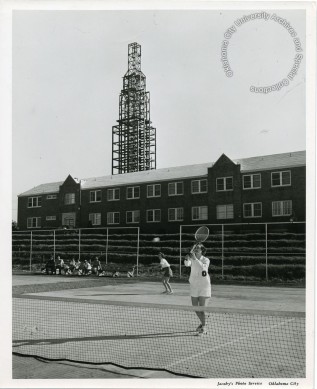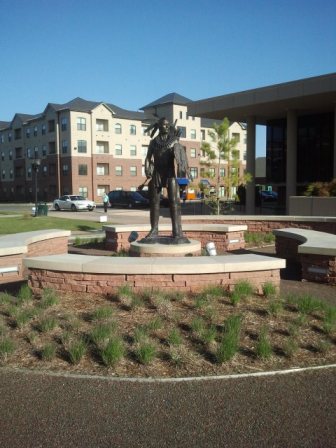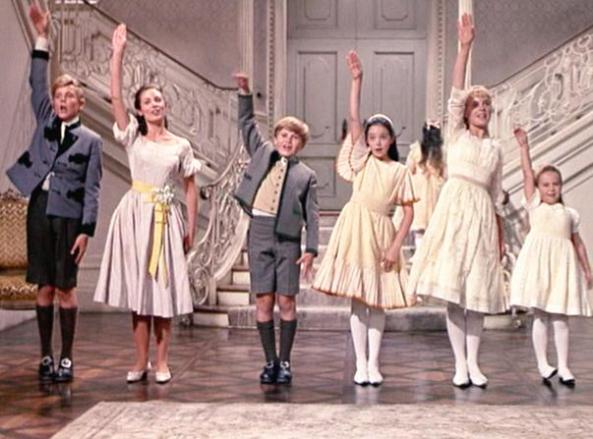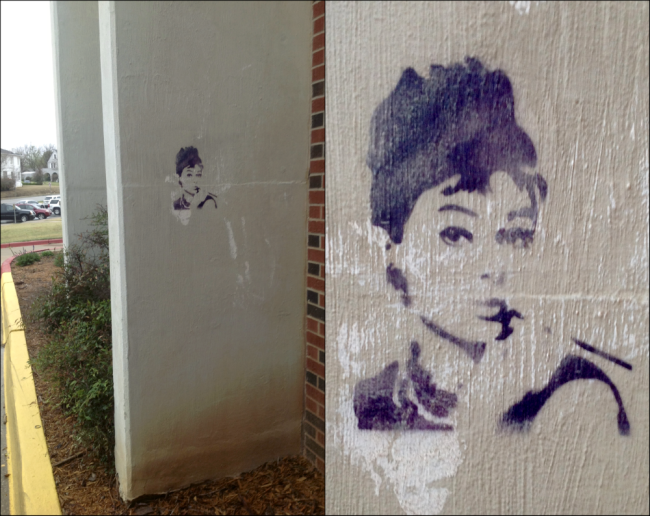
Gold Star, Pennington Hall, and the tennis court in 1950 (Click on the image to see the HistoryPin street-view of this pin)
After my first session of research on the Gold Star Memorial Building in the Oklahoma City Archives and Special Collections, I completely fell in love with the building and its history. That being said, it was a no-brainer when our professors told us to choose an area for our final HistoryPin project.
Through my research, I learned that that Gold Star construction began in April 20, 1949 with a beautiful groundbreaking ceremony. During this ceremony, planes circled overhead waiting to drop flowers among the audience. Exactly one year later, on April 20th 1950, and although construction of the building was not yet complete, there was a dedication ceremony. During this ceremony, OCU officials dedicated the building in honor of the all the young Methodist men and women who had lost their lives in World War II. During 1951, construction on the building was paused due to lack of funds, but resumed in 1952 thanks to fundraising efforts by OCU officials and Oklahoma Methodists churches. Finally, in 1953, Gold Star was complete. In my final HistoryPin project, I made a collection of 10 photos to illustrate a timeline of Gold Star’s construction.

Chickasaw Nation Garden (Click on the image to see the full pin).
Along with my collection, I also pinned the Chickasaw Nation Garden. This was actually the very first item I researched in this class, back in the Monumental Mystery assignment. I felt that, although there was a plaque right next to the garden giving some information, there was still a lot of fun, interesting bits of information that didn’t make it to the plaque. One of the most interesting things I found in my research was the reasoning behind the shape of the garden – the circular shape was intended to mimic the American Indian medicine wheel with an unbroken circular form and the four quadrants within the circle represent the four cardinal directions, the four seasons of the year and the four seasons of life: birth, adolescence, adulthood and death. I also learned that the design uses regional materials, like pink granite and sandstone, along with native plants to reflect the colors and textures of Oklahoma. This is all information I feel is very relevant to the garden, and that onlookers would enjoy knowing when viewing the garden.
While completing my project, I did not encounter any major problems. The software we used was extremely user-friendly, and Professor Wolf was very helpful during our archival research. It definitely helped that we had used the software beforehand with our “Solo Pins” because we then had that first experience to really work out the kinks and get a feel for the software. Overall, this was definitely the most enjoyable final project I’ve ever worked on, and I really enjoy looking back through all the pins and seeing our accomplishments.
Looking back at this year, I learned so much that I never thought I would. My favorite part of class was learning quirky things about OCU’s history, and then having the opportunity to share these amazing findings with the world through HistoryPin. It felt as if we had these cool, little secrets that we could share with everyone else on campus. Even though at times we had so much work to do, and at other times we weren’t exactly sure what we were doing, this class was a really fun ride. Now, as I reflect on everything we have done, I am truly proud of what my class has done. From entering bricks in the Miss America Garden to makings pins on HistoryPin, we have done so much and learned a lot together. Whether it was learning about OCU’s history or how to work in groups, this class truly taught it all. My only hope is that the next class who takes our place enjoys this class and all its projects as much as I did.




